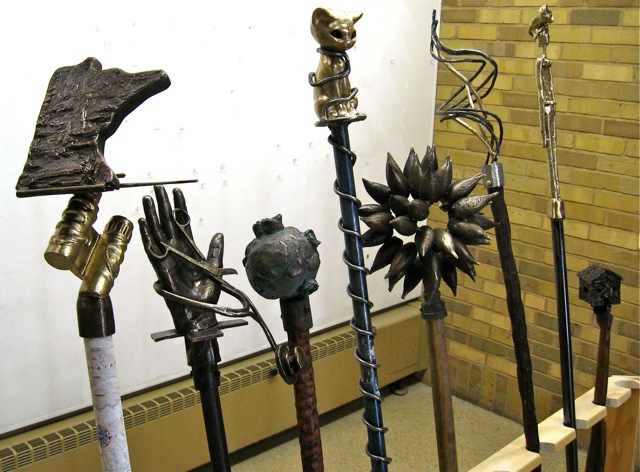Greg Mueller has spent this semester teaching ten Gustavus women about the art of cast metal sculpture. The process of cast metal sculpture began 5000 years ago, incorporating the elements of earth, air, fire, and water. This is also the art form that Paul Granlund, long time Sculptor-in-Residence at Gustavus, used to create the Granlund Sculptures located around campus.
The process of casting metal creates a community activity, as it takes four to five students to have a successful metal pour. Metal casting is just one of the many art classes offered on campus but one of the few that requires teamwork for a successful end to all those involved
The class has had the opportunity to work on a couple of projects including “Sceptres and Staffs” and investigating contemporary “green” trends in the art form as they use re-claimed iron that was salvaged from the St. Peter Community Hospital torn down last year.
“The best part of this class is the amount of freedom and flexibility we have with our work. Greg is an awesome professor and very open to new ideas. I feel like anything you could dream up, he can help make happen which has produced some great final pieces,” Senior Emily Seelen said.
The “Sceptres and Staffs” project took five weeks for the class to complete. It involved making a mold with found objects and wax, using the wax forms to create another mold and then burning the wax out of the new molds. After the mold making, the students worked together to pour the 2000 degree liquid bronze into their molds and then welded the cast pieces together and finished with power grinding tools to perfect the creations.
“My hope is through their personal imagery, symbolism, and inventive forms, students and viewers will see a fresh interpretation of what Gustavus student leaders will look like in the twenty-first century,” Sesquicentennial Sculptor-in-Residence Greg Mueller said.
The type of creations that the students were able to make covered a vast majority of interest areas and passions. The class did not require students to be art majors and there is a mixture of class years. The experience of a liberal arts education allows students on campus to get a sample of many disciplines.
“Art is all around this campus and I wouldn’t have really noticed it honestly, or how it was made, if I wouldn’t have taken this class. Different art forms allow many different possibilities, textures, and projects to be created and expressed,” Junior Rosh Lnu said.
“True artists shouldn’t restrict themselves to a certain area and each form of art has its special beauty,” First-year Yingying Cao said.
Having the chance to directly work hands-on with an art form has given the students the opportunity to take a leading role in what they produce. The “Secptres and Staff” project tapped into the historical legacy of the staff as a representation for kings, military, or religious power. The meaning behind the staff allowed the students to show how they wanted to lead their futures.
“In the short time I have known these young women, I am confident every one of them, some may not know it yet, will find themselves in a future leadership role someday,” Mueller said.
